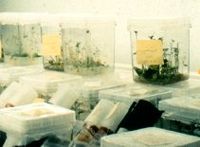
Photo from wikipedia
Biotic elicitation is an important biotechnological strategy for triggering the accumulation of secondary metabolites in adventitious root cultures. These biotic elicitors can be obtained from safe, economically important strains of… Click to show full abstract
Biotic elicitation is an important biotechnological strategy for triggering the accumulation of secondary metabolites in adventitious root cultures. These biotic elicitors can be obtained from safe, economically important strains of bacteria found in the rhizosphere and fermented foods. Here, we assayed the effects of filtered cultures of five nitrogen-fixing bacteria and four types of fermentation bacteria on mutant adventitious Panax ginseng root cultures induced in a previous study by colchicine treatment. The biomass, pH, and electrical conductivity (EC) of the culture medium were altered at 5 days after treatment with bacteria. The saponin content was highest in root cultures treated with Mesorhizobium amorphae (GS3037), with a concentration of 105.58 mg g−1 dry weight saponin present in these cultures versus 74.48 mg g−1 dry weight in untreated root cultures. The accumulation of the ginsenosides Rb2 and Rb3 dramatically increased (19.4- and 4.4-fold, and 18.8- and 4.8-fold) 5 days after treatment with M. amorphae (GS3037) and Mesorhizobium amorphae (GS336), respectively. Compound K production increased 1.7-fold after treatment with M. amorphae (GS3037) compared with untreated root cultures. These results suggest that treating mutant adventitious root cultures with biotic elicitors represents an effective strategy for increasing ginsenoside production in Panax ginseng.
Journal Title: Applied Microbiology and Biotechnology
Year Published: 2018
Link to full text (if available)
Share on Social Media: Sign Up to like & get
recommendations!